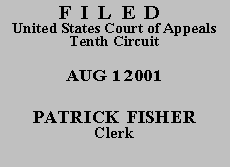

| UNITED STATES OF AMERICA,
Plaintiff-Appellee, v. VINCENT JEROME RIDLEY, Defendant-Appellant. |
|
Defendant Vincent Jerome Ridley appeals the district court's denial of his motion to vacate, set aside, or correct his sentence, brought pursuant to 28 U.S.C. § 2255. Because defendant has not made a substantial showing of the denial of a constitutional right, we deny his application for a certificate of appealability and dismiss the appeal.
In July 1997, defendant pled guilty to one count of possessing a controlled substance with intent to distribute, and in October 1997, he was sentenced to seventy-eight months' incarceration. Because the offense involved crack cocaine, the sentence was significantly higher than it would have been for cocaine powder or a non-crack form of cocaine base. See U.S. Sentencing Guideline Manual § 2D1.1(c)(7) & Note D (1998); United States v. Kissick, 69 F.3d 1048, 1052 (10th Cir. 1995). On May 13, 1999, defendant filed this § 2255 motion, alleging his trial attorney was ineffective by not objecting to the enhanced sentence or requiring the government to prove that the controlled substance was "crack cocaine." After a hearing, the district court determined that the substance was, indeed, crack cocaine, and therefore counsel was not ineffective. Defendant appeals.
Before we may consider this appeal, defendant must obtain a certificate of appealability by making a substantial showing of the denial of a constitutional right. 28 U.S.C. § 2253(c). Defendant argues there was no evidence from which the district court could determine that the substance was crack cocaine, and that the undisputed evidence was that the nature of the substance could not be determined simply by looking at it. He argues that this evidence demonstrates he was deprived of the effective assistance of counsel.
After reviewing the record, we conclude there was more than enough evidence, including defendant's own admissions, to support the district court's finding that the substance involved was crack cocaine. The district court based its finding on police testimony that the seized substance was in the form of crack cocaine; testimony by the chemist who tested the substance that she had never tested cocaine base in any form other than crack cocaine, that she had never tested coca paste, and that she usually used the description "white 'rock'/powder" to describe crack cocaine; testimony by defendant's attorney that defendant admitted selling crack cocaine from his car; and the inconsistency of defendant's affidavit stating that the substance was not crack cocaine with his later testimony that he did not know what the substance was. R. I, doc. 79 at 4.
In addition to the evidence identified by the district court, which in itself supports the court's factual finding, defendant clearly admitted that the substance involved was crack cocaine. Count I of the indictment, to which defendant pled guilty, charged him with possession of "cocaine base (crack cocaine)." Id., doc. 1. Further, at the plea hearing, defendant testified under oath that he understood he was being charged with possessing "crack cocaine," R. III at 6; that he understood one of the essential elements of the charge to which he was pleading guilty was that the substance was "crack cocaine," id. at 15; and that after hearing the government's proposed proof that he possessed "crack cocaine," he was willing to plead to the charge, id. at 16-17. Based on these admissions, the government was relieved of its burden at sentencing to show that the substance was crack cocaine, and defendant's attorney was not ineffective in failing to put the government to its burden. United States v. Gray, 182 F.3d 762, 768 (10th Cir. 1999) (holding defendant's guilty plea to indictment specifying that the substance was "cocaine base 'crack'" and admissions in petition to plead guilty and at the plea hearing that substance was "crack" relieved the government of burden at sentencing and therefore counsel was not ineffective).
Defendant's motion for a certificate of appealability is DENIED and the appeal is DISMISSED.
Entered for the Court
Circuit Judge
*. This order and judgment is not binding precedent, except under the doctrines of law of the case, res judicata, and collateral estoppel. The court generally disfavors the citation of orders and judgments; nevertheless, an order and judgment may be cited under the terms and conditions of 10th Cir. R. 36.3.